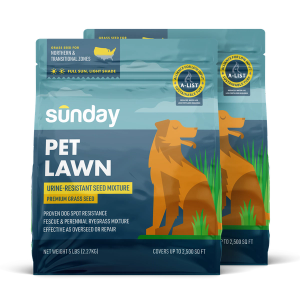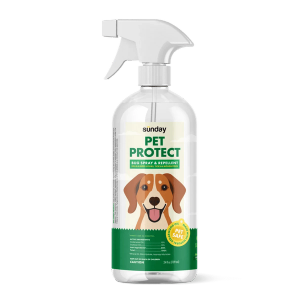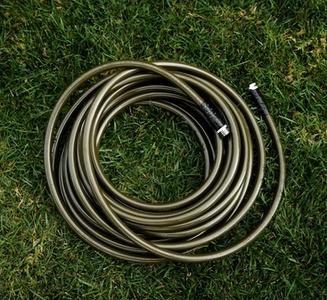Best time to mow your lawn
So you’ve figured out what nutrients that your lawn needs and how much water it needs (nice!). But what about how much mowing it needs—and when? While you may think that the best time to mow your lawn is any time that it gets too long and unmanageable, that’s simply not the case. There is, in fact, a best time to mow. Let’s dig in.
Time of year
The best time of year to mow your lawn is when your grass is actively growing. After winter, allow your grass to recover from the frosty, cold months, and begin to grow again. This exact time can fluctuate based on your location and the weather—which can be unpredictable year to year. A good rule of thumb: Start mowing when your grass type has grown back to optimal mowing height.
Time of day
Once you do decide it’s mowing day—and you lace up your lawn sneakers—aim to mow either during the mid-morning or late afternoon. Mid-morning allows dew from overnight to evaporate, so you’re not mowing wet grass, and late afternoon avoids midday heat and increased stress on turf.
How often to mow
The rate at which your grass grows will vary, and this will be the main determining factor of how often you need to mow. Typically, during the growing season, mowing once a week should be sufficient for keeping your lawn well-manicured and healthy.
When to avoid mowing your lawn
There are specific times when you shouldn’t mow, as it could cause more harm than good to your lawn. Avoid mowing when...
…fertilizer was just applied
While you can mow and then apply nutrients, we don’t recommend mowing right after applying your Sunday nutrients. For best results, wait at least two days after applying Sunday nutrients before cutting your grass to ensure nutrients are absorbed properly.
...grass is wet
You should avoid mowing when the grass is wet. Mowing wet grass can lead to uneven cuts and mower issues—plus it can damage your lawn. Heavy traffic across the lawn while the grass or soil is wet can lead to soil compaction issues.
...grass is stressed
Don’t mow during times of extreme heat or drought. During these times, your turf is stressed, and mowing can cause excess damage. Fun fact: That freshly mown grass smell we all love is actually a distress signal! So mow with care.
When to stop mowing for the year
This is refreshingly simple: Stop mowing when the grass stops growing. How do you figure this out? You’ll notice fewer clippings leftover after you mow. It may be obvious that grass isn’t increasing in height any longer, and for some grass types, it may lose its deep green color.
Bonus lawn mowing tips
We’ve covered the whens, so let’s touch on some hows. Keep these rules and best practices in mind as you’re mowing.
- Take a break after applying Sunday. In general, Sunday nutrients will offer best results if they're applied to grass that isn't stressed—aka, freshly mowed. Our rule of thumb is to mow first, wait at least two days, and then apply your nutrients to your lawn. This allows the grass to recover from mowing stress and will result in better absorption. If you mow after you apply nutrients for some reason (we've all been there!), don't worry too much. The light stress of mowing won't prohibit grass from absorbing the nutrients altogether—and most of the nutrients are absorbed from the soil by the root systems.
- Maintain your mower. It’s important to maintain your mower throughout the season to make sure it’s working hard for you. Before you rev up the mower for the season, sharpen your mower blades to avoid tearing and damaging turf blades. This is important because shredded or torn grass blades can lead to disease susceptibility, or your grass drying out and requiring more supplemental watering.
- Don’t cut your grass too short. As a good rule of thumb, avoid cutting more than ⅓ of the leaf blade at a single time, as that can damage the grass plant. Mowing high helps deter weeds, increase photosynthesis abilities (more blade surface), and promotes deeper rooting.
- Grasscycle. If you’re not already grasscycling, now’s the time to try. Grasscycling is simply leaving your grass clippings on the lawn after mowing, and letting them work their magic. Not only is grasscycling the most sustainable way to compost your clippings, it’s also a way to add free nutrients back to your lawn.
- Protect flowering clover and pollinators. If you’re growing a clover lawn, raise the mowing height a touch if possible, and only mow early morning or late evening to avoid heavy bee traffic. This will help you avoid conflict with foraging bees in your clover lawn.
- Mow less in May. Consider mowing your lawn less (but don’t fully stop) during the earliest parts of spring. Early foraging pollinators need flowering plants and your grass can offer a flowering plant habitat, if you let it. Mowing every two weeks actually helps your grass, while helping our local ecosystems too.
- Upgrade your tools. One easy way to reduce emissions is by getting better tools. Consider switching to an electric mower for a healthier, greener (in color and in eco-friendliness) lawn.
Does mowing matter, anyway?
Short answer: yes. Long answer: absolutely yes. Proper technique—including everything we discussed above—benefits your grass in many ways, including the following:
Deeper rooting
Mowing not only helps to keep your grass at a manageable length, but also encourages deeper underground rooting, which leads to stronger, healthier grass.
Lateral growth
Turfgrass in nature evolved from wildlife and livestock grazing. Meaning when animals grazed on turfgrass, it eventually evolved to spread laterally on the ground. Since your lawn (hopefully) isn’t being grazed upon, mowing acts almost as an artificial means of this, so when you mow, your grass is actually spreading laterally across your lawn—leading to denser, thicker grass.
Fewer weeds
A lawn with deep roots and lateral growth will, in turn, have fewer weeds. When you have deeper roots and greater turfgrass canopy, you have fewer pockets for weeds to germinate or grow in across your lawn.
Added nutrition
In addition to making your lawn look better, proper mowing can actually create a more nutrient-dense lawn. When you mow and leave your grass clippings, you’re increasing available (and free!) nutrients to your lawn. Meaning, again, healthier grass.
Cited sources
Mowing practices for healthy lawns. UMN Extension.



















